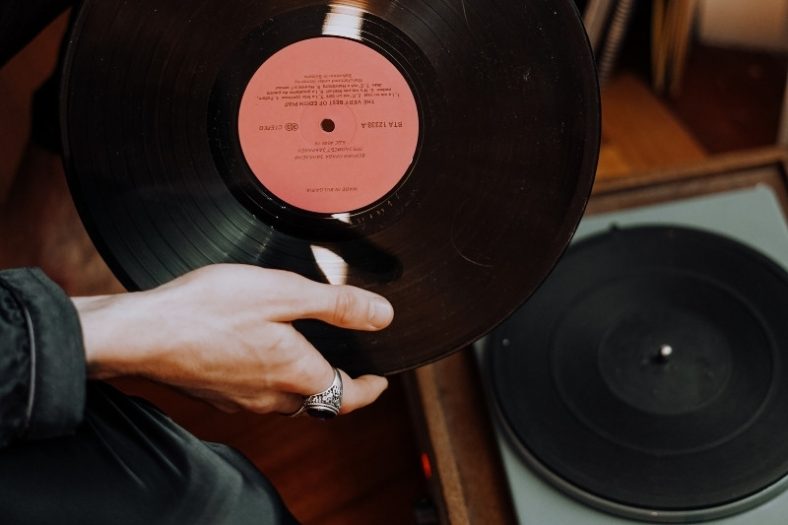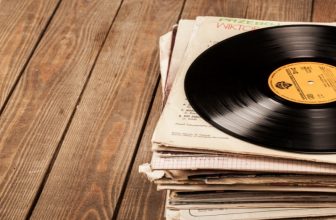Vinyl Record Sizes and Speeds (An Easy Guide)

You don’t have to be a vinyl expert to notice that vinyl records come in different sizes. Most commonly, vinyl collections include 7″ and 12″ records. These records play at different speeds, signaled by the words 33 RPM or 45 RPM.
You have probably heard about these different sizes and speed variations before, but do you know what they truly mean? In this article, I will shed some light on the subject.
Contents
How Many Vinyl Record Sizes Are There?
Officially, there are three available vinyl record sizes: 7″, 10″, and 12″. However, 10″ records are relatively rare. Inconveniently, 10″ records are not supported by most turntables and may be hard to come by. Simply put, most vinyl collections are made of 7″ and 12″ records.
Most commonly, 7″ records allow for about three minutes of stored music per side; some people call them singles, as most commercially available 7″ records feature just one song per side. On the other hand, 12″ records store approximately 22 minutes of music per side; they’re often known as albums or LPs.
In most cases, 12″ records make for complete albums with a total duration of about 35 to 40 minutes; however, some electronic dance music 12″ records feature just 7 to 8 minutes per side—this way, they can fit louder tunes with more bass frequencies, which is a must in the genre (you can learn more about it here).
As for 10″ records, they make for a collector’s novelty nowadays. Since they cannot be played on most turntables, they are considered outdated. Their origin goes back to the year 1910, when the first music records were still made out of shellac—a more rigid alternative to vinyl—and usually stored nine to 12 minutes of music per side.
Why Do Vinyl Record Sizes Matter?
Vinyl record sizes matter because they determine the amount of music that can be stored on each side of the record.
Audio is analogically pressed into vinyl, meaning that the material size of the record is important for the amount of audio it can store.
Interestingly enough, a song’s duration isn’t the only aspect that should be considered when evaluating how many minutes of music can be stored per side. Purely sonic factors such as the audio-dynamic range, the amount of bass, the number of high frequencies, and the stereo width can also play a pivotal role.
However, size isn’t the only aspect vinyl collectors should take into account. The velocity at which a record plays is also very essential for determining a record’s maximum duration, and it can even affect sound quality.
That’s why it’s critical to learn about vinyl speeds and understand the differences between 33 RPM and 45 RPM.
How Many Vinyl Record Speeds Are There?
There are three vinyl record speeds: 33 RPM, 45 RPM, and 78 RPM.
The first two are by far the most common, as 78 RPM records make for a rarity nowadays. RPM stands for revolutions per minute and refers to the number of rotations the record makes per minute while being played on a turntable.
Records with 33 RPM will rotate thirty-three times per minute, records with 45 RPM will rotate forty-five times per minute, and so on. Unlike records with 78 RPM, 33 and 45 RPM records are considered to be a standard and supported by virtually all turntables. The number of revolutions per minute in a record directly impacts its duration and sound quality.
What’s the Difference Between a 33 RPM Record and a 45 RPM Record?
Records playing at 33 RPM are slower than records played at 45 RPM, meaning they can store more minutes of music per side. Many audiophiles favor 45 RPM records over 33 RPM records because they believe they sound better.
This is more than just a collector’s whim—in fact, it makes perfect sense. The more revolutions per minute in a record, the more information it will be able to play at a given moment.
The idea that more RPM equates to better sound quality can be easily tested by playing a record at a very low speed. Whether you’re manually rotating a vinyl record or playing an old, rusty cassette in your car, slow rotations will always result in loss of sound quality. The music starts to drag, the high pitches tend to drop and get lower, and unwanted sound artifacts start popping up constantly.
This may help to explain why, while 33 RPM records allow for more music, 45 RPM vinyl is often viewed as the current best available choice.
| Useful information: For the sake of accuracy, I believe it’s important to mention that 33 RPM records don’t actually play at 33 revolutions per minute. To be precise, they rotate at 33 and 1/3 RPM. They’re known as 33 RPM records merely because it’s simpler. |
What About 78″ RPM Records?
Pretty much like 10″ vinyl records, 78 RPM records are treated as a novelty. Its origin can also be traced back to the beginning of the 20th century, and they were discontinued before 1960. Nowadays, almost no one produces 78 RPM records, as they cannot be played on most turntables.
The earliest available 78 RPM records (which were actually played at 78.26 revolutions per minute) date back to 1888, the year the German-American inventor Emile Berliner created the lateral-cut flat disc record, one of the earliest precursors of the vinyl record.
While 78 RPM are seldom produced and no longer used by modern-day engineers and musicians, they make for invaluable collector’s items. They are so rare that most 78 RPM records dating back to the first half of the 20th century can sell for an average of $1.5K to $5K.
Summary
Any music fan has heard about 7″ and 12″ records and seen the labels 33 RPM and 45 RPM written on an album’s cover. For the most part, these are simply standard sizes and speeds defined by the record production industry and supported by most common turntables. However, audiophiles should be aware of what they mean.
In short, record sizes and speed are important because they have a direct impact on the duration of the music per record size, as well as a tangential effect on a record’s sound quality. Records with a size of 10″ and 78 RPM are still available, but they’re outdated and should be considered a collector’s item.





